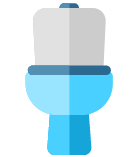How Do The Showers/Bathrooms Work
Showers and bathrooms are essential elements of our daily lives. We rely on them to keep ourselves clean and fresh. But have you ever stopped to think about how showers and bathrooms actually work? In this article, we will explore the inner workings of showers and bathrooms, from the plumbing to the fixtures, and everything in between.
The Basics of Plumbing:
Before we can dive into how showers and bathrooms work, we need to understand the basics of plumbing. Plumbing is the system of pipes, valves, and fixtures that carry water in and out of a building. When you turn on the tap in your shower or bathroom sink, water is delivered to you through a network of pipes that run throughout your home. The water is under pressure, which allows it to travel through the pipes and out of the fixtures.
Water Supply:
The first step in the process of taking a shower is the water supply. Most homes are connected to a municipal water supply, which delivers clean and treated water to your home. The water enters your home through a main water line and is then distributed to different fixtures, including your shower and bathroom sink.
Water Heating:
Once the water enters your home, it may need to be heated before it can be used for a shower. Water heaters are responsible for heating the water that comes out of your showerhead. There are different types of water heaters, including tankless water heaters and traditional tank water heaters. Tankless water heaters heat water on demand, while tank water heaters store and heat water in a tank until it is needed.
Shower Fixtures:
The shower fixtures in your bathroom are what control the flow and temperature of the water. The most common shower fixture is the showerhead, which is attached to a pipe that delivers water from the main supply. When you turn on the shower, water flows through the pipes and out of the showerhead. Some showers may also have additional fixtures, such as body jets or a handheld sprayer, that can enhance the showering experience.
Drainage:
Once you’ve finished your shower, the water needs to be drained away. Drains are responsible for carrying away used water and preventing it from pooling in your shower or bathroom. The drain in your shower is connected to a pipe that carries the water to the main sewer line or septic system. It’s important to keep your drains clear and free of debris to prevent clogs and backups.
Ventilation:
Proper ventilation is essential in a bathroom to prevent moisture buildup and mold growth. Bathrooms are often equipped with exhaust fans that help remove steam and odors from the air. Ventilation fans are typically installed in the ceiling or wall and are connected to ductwork that leads outside. Good ventilation can help maintain a healthy and comfortable bathroom environment.
Maintenance and Repairs:
Like any other system in your home, showers and bathrooms require regular maintenance and occasional repairs. It’s important to keep an eye out for leaks, drips, or other issues that could indicate a problem with your plumbing or fixtures. If you encounter a problem, it’s best to contact a professional plumber to diagnose and repair the issue.
Conclusion:
Showers and bathrooms are essential features of our homes that we rely on every day. Understanding how showers and bathrooms work can help you better appreciate the systems that keep you clean and comfortable. From the water supply to the fixtures to the drainage, each element plays a crucial role in providing you with a refreshing shower experience. By following proper maintenance and repairs, you can ensure that your showers and bathrooms continue to work efficiently for years to come.
